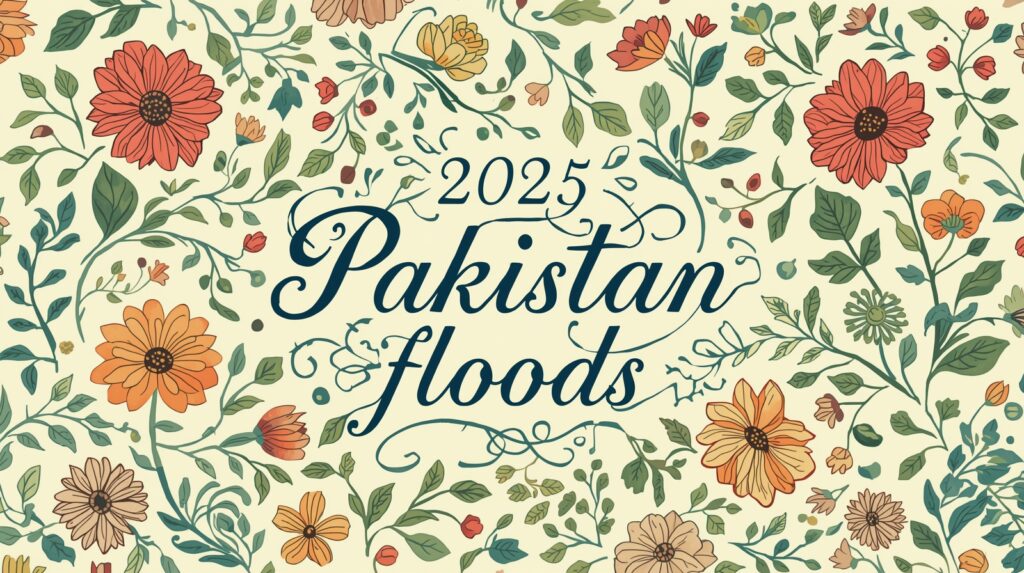.
Pakistan’s bond with nature is still quite weak, as shown by the year 2025. The country has been hit hard by heavy rains, rivers overflowing, and floods that have never happened before. Millions of people in Sindh, Punjab, Khyber Pakhtunkhwa, and Balochistan have been affected. The 2025 Pakistan floods not only inflicted a lot of damage, but they also brought back to life the critical discussion about climate change, poor infrastructure, and disaster preparedness in South Asia’s fifth most populated country.

How the 2025 Floods Started: Unfolding the Disaster
The floods began in late July 2025, following weeks of persistent monsoon rainfall that exceeded historical norms by approximately 40%. Rivers like the Indus and Chenab overflowed, flooding whole villages. Satellite footage showed that more than one-third of southern Sindh was underwater at one time. Urban regions, especially Karachi, Hyderabad, and Sukkur, had significant drainage failures, converting streets into rivers.
The National Disaster Management Authority (NDMA) said that more than 15 million people were directly affected, and hundreds had to leave their homes. Rescue activities were begun by the Pakistan Army, NDMA, and many NGOs, although access to distant areas remained difficult due to damaged roads and washed-away bridges.
Economic Toll: Billions Lost Overnight
The economic impact of the 2025 floods is tremendous. Early estimates suggest damages exceeding $12 billion, affecting agriculture, livestock, and infrastructure. Sindh and Punjab—Pakistan’s breadbasket regions—saw massive destruction of crops like wheat, rice, and cotton. Farmers reported losing not just harvests but also the land’s fertility due to heavy silt deposits.
Industries suffered too. Many small factories in flood-prone locations were forced to close down, leading to employment losses and a fall in exports. Economists worry that the flood disaster could delay Pakistan’s GDP growth by about 1.5% this fiscal year, worsening an already frail economy suffering with inflation and debt.
Human Suffering and Health Crisis
Behind the statistics lies a human tragedy. Families lost not just homes but loved ones, and the emotional toll is severe. Relief camps are overcrowded, and essential facilities like clean drinking water, food, and medical supplies are lacking. The flooding have led to outbreaks of waterborne diseases such as cholera, dengue, and malaria, mainly in Sindh and southern Punjab.
The World Health Organization (WHO) and UNICEF have stepped in with emergency health support, but the size of the problem is beyond what international aid alone can address. Pakistani physicians and volunteers are working tirelessly, yet thousands remain without access to healthcare.
Climate Change and Pakistan’s Vulnerability
Experts feel that the 2025 floods are not simply a natural calamity but a climate-induced disaster. Pakistan contributes less than 1% to global greenhouse gas emissions, although it is among the top ten most vulnerable countries to climate change. The rise in global temperatures has strengthened monsoon patterns, melting glaciers in the north, and increasing the risk of flash floods in low-lying places.
This is not the first warning. The 2022 floods ravaged one-third of the country, and now, only three years later, history has repeating itself. Scientists and environmentalists warn that unless Pakistan invests in sustainable water management, climate-resilient infrastructure, and reforestation, such calamities will become an annual occurrence.

Government Response and Relief Efforts
The Government of Pakistan has proclaimed a national emergency. Prime Minister and provincial leaders have visited impacted districts, promising immediate help and long-term reconstruction. The government established the “Rebuild Pakistan 2025” plan, focused on rehabilitation, financial aid for farmers, and disaster-resistant housing.
International aid has also poured in. The United Nations, World Bank, and Asian Development Bank (ADB) have pledged billions in assistance packages. Countries including Turkey, Saudi Arabia, China, and the UAE have contributed food supplies, tents, and medical crews. Despite these attempts, coordination challenges and corruption concerns continue to hinder effective delivery to ground-level victims.

The Role of Media and Social Awareness
In this digital age, social media has played a crucial role in promoting awareness. Hashtags like #PakistanFloods2025, #PrayForPakistan, and #ClimateJustice have trended globally. Influencers, journalists, and ordinary individuals are using platforms like X (previously Twitter), TikTok, and Instagram to communicate real-time updates and rally donations.
However, disinformation has also circulated, producing alarm and uncertainty. It underscores the need for responsible reporting and verified news sources during national emergencies.
Lessons for the Future: Building Climate Resilience
The 2025 floods are a harsh lesson—but also a call for change. Pakistan must move beyond reactionary measures and focus on climate resilience. Experts recommend:
- Modernizing drainage systems in metropolitan centers.
- Building stronger dams and levees along key rivers.
- Reforesting deforested regions to decrease soil erosion.
- Educating communities about early warning systems.
- Investing in renewable energy to lessen carbon impact. The route forward demands harmony between the government, private sector, and citizens. Disaster preparedness must become a part of national policy, not just an emergency response.
A Nation’s Strength Amidst Suffering
Despite the devastation, stories of courage and humanity shine through. Volunteers saving strangers, youngsters collecting funds, and locals sharing food with displaced families – these acts of generosity reflect the true spirit of Pakistan. The resilience of the people remains unshaken, even when the waters rise.



